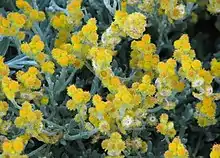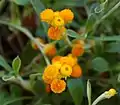| Chrysocephalum | |
|---|---|
 | |
| Chrysocephalum apiculatum | |
| Scientific classification | |
| Kingdom: | Plantae |
| Clade: | Tracheophytes |
| Clade: | Angiosperms |
| Clade: | Eudicots |
| Clade: | Asterids |
| Order: | Asterales |
| Family: | Asteraceae |
| Subfamily: | Asteroideae |
| Tribe: | Gnaphalieae |
| Genus: | Chrysocephalum Walp. |
| Synonyms[1] | |
| |
Chrysocephalum, known by the common name everlastings for their long life as cut flowers, is a genus of flowering plants in the family Asteraceae. There are nine species, all of which were formerly classified under other genera (Helichrysum, Helipterum and Leptorhynchos).
- Species
All the species are endemic to Australia.[1]
- Chrysocephalum apiculatum (Labill.) Steetz - common everlasting, yellow buttons
- Chrysocephalum baxteri (A.Cunn. ex DC.) Anderb.
- Chrysocephalum eremaeum (Haegi) Anderb.
- Chrysocephalum gilesii (F.Muell.) Paul G.Wilson
- Chrysocephalum pterochaetum F.Muell. - perennial sunray
- Chrysocephalum puteale (S.Moore) Paul G.Wilson
- Chrysocephalum semipapposum (Labill.) Steetz - clustered everlasting, yellow buttons
- Chrysocephalum sericeum Paul G.Wilson
- Chrysocephalum vitellinum Paul G.Wilson
Gallery
 The cultivar C. apiculatum 'Flambe Orange'
The cultivar C. apiculatum 'Flambe Orange' Foliage of 'Flambe Orange'
Foliage of 'Flambe Orange'
References
- 1 2 Flann, C (ed) 2009+ Global Compositae Checklist Archived 2014-11-07 at archive.today
This article is issued from Wikipedia. The text is licensed under Creative Commons - Attribution - Sharealike. Additional terms may apply for the media files.